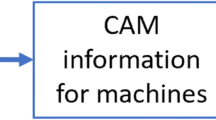3D scanning is widely used in prosthetics and orthotics all over the world. Involuntary movements of the subject, variability of the scanning conditions, and the human factor (operator’s errors) may reduce the accuracy of scanning and disrupt the surface structure of the recorded electronic geometric model, i.e., lead to the appearance of artifacts and defects. The article discusses the main causes of artifacts and makes an attempt at their systematization. Methods for eliminating artifacts during mobile laser non-contact 3D scanning and processing using Autodesk Meshmixer software are described.
Similar content being viewed by others
References
Tishkin, V. O., “A technique for assembling and processing data obtained during 3D scanning,” Nauch.-Tekh. Vestn. SPbGU ITMO, No. 1, 87-92 (2011).
State Standard GOST R 57558–2017: Additive Manufacturing. General Principles. Part 1. Terms and Definitions.
Zanuttigh, P., Marin, G., Dal Mutto, C., Dominio, F., Minto, L., and Cortelazzo, G. M., Time-of-Flight and Structured Light Depth Cameras Technology and Applications, Springer (2016), p. 355.
Ryniewicz, A., Ryniewicz, A., Bojko, Ј., Goікbiowska, W., Cichoсski, M., and Madej, T., “The use of laser scanning in the procedures replacing lower limbs with prosthesis,” Measurement, 112, 9-15 (2017).
Mak, A. F.-T., Zhang, M., Leung, A. K.-L., and Prado da Silva, M. H., Artificial Limbs. Reference Module in Materials Science and Materials Engineering (2017), pp. 1-34.
Herr, H. M., Moerman, K. M., and Sengeh, D. M., Method and System for Designing a Bbiomechanical Interface Contacting a Biological Body Segment, US Patent Application US20190021880A1.
Colombo, P. et al., “Development of a virtual testing laboratory for lower limb prosthesis,” in: Scuola di dottorato di ricerca in ingegneria industriale. Indirizzo: ingegneria chimica, dei materiali e della produzione. Ciclo XXVI (2014), p. 133.
Botsch, M. and Sorkine, O., “On linear variational surface deformation methods,” IEEE Trans. Visual. Comp. Graph., 14, No. 1, 213-230 (2008).
Author information
Authors and Affiliations
Corresponding author
Additional information
Translated from Meditsinskaya Tekhnika, Vol. 54, No. 2, Mar.-Apr., 2020, pp. 38-41.
Rights and permissions
About this article
Cite this article
Shcherbina, K.K., Golovin, M.A., Suslyaev, V.G. et al. An Electronic Geometric Model for 3D Scanning of Human Body Segments and Its Use in Prosthetics and Orthotics. Causes of Defects and Methods for Their Elimination. Biomed Eng 54, 130–134 (2020). https://doi.org/10.1007/s10527-020-09989-z
Received:
Published:
Issue Date:
DOI: https://doi.org/10.1007/s10527-020-09989-z




